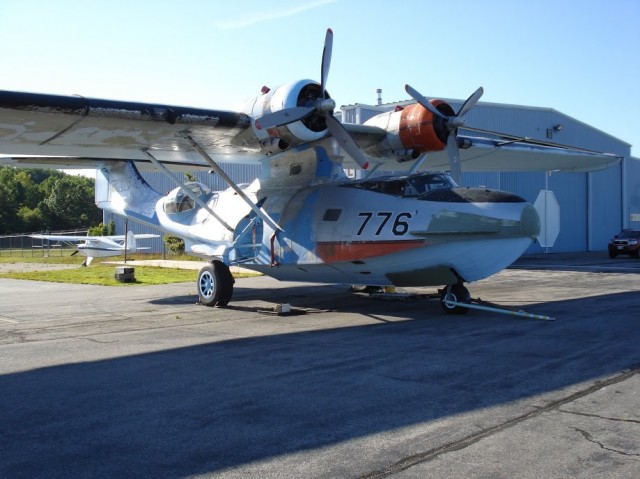
A PBY with lots of potential located at KSFM
This story was written by Michael Lothrop for AirlineReporter…
Sanford Seacoast Regional Airport (KSFM) is a municipally-owned airport located in Sanford, Maine. It is home to a fixed wing flight school, rotary wing flight school, a school specializing in ATP licenses, as well as a full host of FBO services. There is also an excellent diner to facilitate the infamous ’œ$100 hamburger’.
KSFM was originally a Naval Auxiliary Airfield during World War II, built at the same time as three others in the state. It has also been the host to Presidential aircraft, as both Bush administrations were keen to visit Kennbunkport.
It’s only fitting that an old Navy airfield would play host to an old Navy plane. Every now and then, one can get a glimpse of a hulking amphibious aircraft tied down on the far side of the field. I was fortunate enough to be put in touch with the private concern who owns this magnificent aircraft, and was granted an interview about the PBY Catalina. Here are some questions and answers from that session:
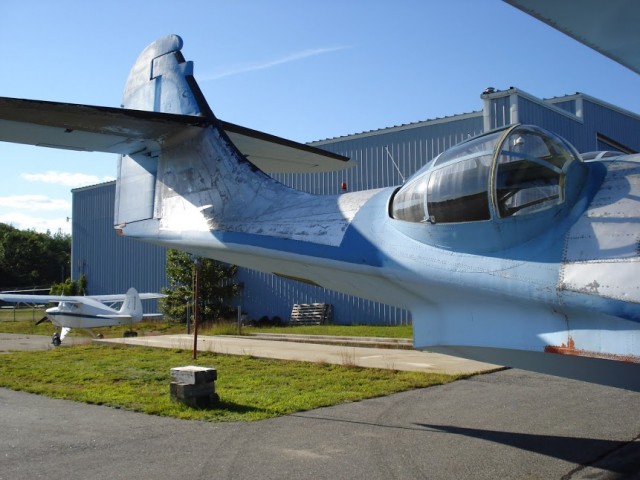
The tail of the PBY at Sanford
Along with the green grass and sunny weather, a PBY is known to blossom around the Sanford Seacoast Regional Airport.
AirlineReporter: What brought the PBY to Sanford?
PBY Owner: Our goal was to find a plane that would get people excited about flying and that would be fun to fly, too. The PBY certainly gets a lot of people’s attention and gets them to think about flying. We’re looking forward to the fun flying.
AR: What model exactly is our local PBY, and in what year was it built?
PBYO: The PBY at Sanford is a PBY-5A. The ’œA’ is for amphibian. The first PBY was built in 1936. There were several modifications done to the design over the next few years, resulting in the PBY-2, -3, and -4. In 1940, the PBY-5 was introduced which, like the earlier models, was a flying boat ’“ it could only land on water. In 1941, they produced an amphibious airplane for the first time, which could land on water or land – the 5A.
The ’œPB’ in the name is for Patrol Bomber ’“ the two primary roles of the aircraft at war. The ’œY’ is the manufacturer’s designation, Consolidated Vultee (’œC’ was already used for Curtis). Technically, our airplane is an OA-10A. That is the Army Air Force designation. PBY is the Navy designation. Our particular airplane was delivered to the U.S. Army Air Force on July 31, 1944.
The PBY-5 and PBY-5A were produced from 1939 to 1945, when they then started producing the PBY-6A. That was the last model produced. Over 3,000 PBYs were built by the time production ceased in 1946.
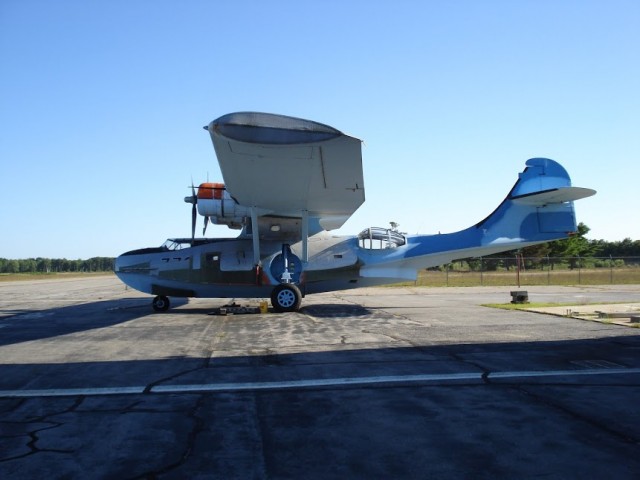
Side profile of the PBY with an interesting paint job
AR: Do you know anything of its service history and lineage since ’œretiring’ from the service?
PBYO: Our plane was originally delivered to Keesler Army Air Force Base in Biloxi, Mississippi. In 1947, this became Keesler Air Force Base. I have been in contact with the base historian. He does not have any history of specific PBYs at the base.
I do know that there was a search and research school that was started at Keesler on July 31, 1944 ’“ the same day they received our airplane. I suspect that it was used in that school.
We do know that the plane was sold as military surplus in 1947. At that time, it had about 1,000 hours of operation. It changed hands a few times, then was converted to a civilian airplane in 1954. It then was sold a few more times, occasionally heading to Canada then back to the United States.
It was converted for use as a fire-fighting bomber in 1977. This involved the installation of a 900-gallon water tank, some bomb bay doors, and other modifications. It then went to Canada, presumably for use in fighting forest fires.
It was retired from fire fighting in about 1992. It was in storage in Washington State until 2002, when it was purchased by Buffalo Joe, of Ice Pilots fame. It sat for a couple more years, then was flown to Red Deer, Alberta, Canada, where it rested. Eventually it was sold and flown to Sanford, in about 2006.
AR: There is a videos of the PBY floating around the internet doing an engine run up? Is it currently able to be flown?
PBYO: The PBY is very close to being air-worthy. Our biggest hurdle is documenting the maintenance procedures as originally outlined by the manufacturer, as required by the FAA for an Airworthiness Certificate.
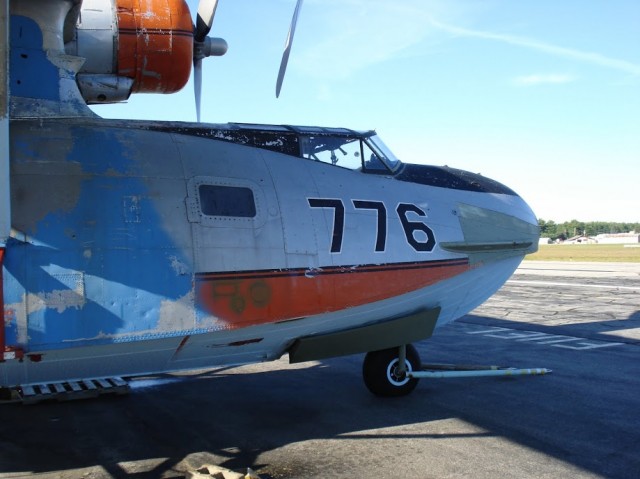
Close-up of the nose of the PBY
AR: As far as structural components, have any other PBY’s given their life to get this one back to the skies?
PBYO: As far as I know, all of the major components of this airplane are original. A lot of small parts have been replaced over the years. Getting parts can be a problem with an airplane that hasn’t been manufactured in over 60 years. The internet has made it easier. There are people scattered around the planet who have stashes of old PBY parts.
AR: Are the engines original or original spec?
PBYO: The engines are as originally specified for the aircraft, but they are not the original engines. With working airplanes, it is common practice to remove one engine and replace it with one another that is already overhauled. The operator can not afford to have a plane sitting around waiting for an engine.
The PBY-5A uses the same engines as the DC-3 (Pratt & Whitney R-1830-92, 1200 hp, 14-cylinder). This is a big help; the popularity of the DC-3 means that there are plenty of engine parts available.
AR: I understand that corrosion in seaplanes can be quite the issue; what challenges have you faced in the restoration process with this, or other issues?
PBYO: This airplane was is in pretty good shape as far as corrosion. That is really an issue with airplanes that have been used in salt water. This one was probably used in salt water in the military, and there is documentation of several panels of the aluminum skin being replaced many years ago. For the past 40 years or so, it has been limited to fresh water operations. We had to rebuild the tunnel hatch because of corrosion, but the skin that has been replaced was because of dents, most likely from docking.
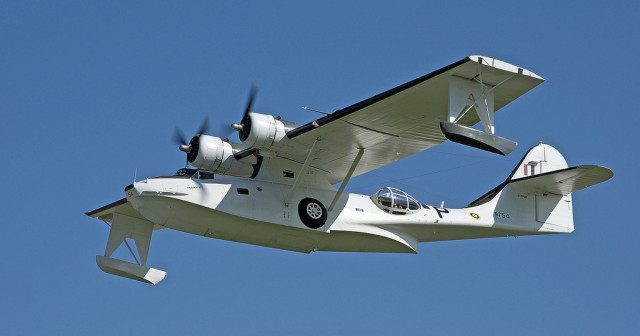
A restored and flying PBY – Photo: rsteup / Flickr CC
AR: While simplistic compared to modern aircraft, there aren’t many folks left who worked on these extensively. What kind of learning experience has it been resurrecting this aircraft?
PBYO: There are mechanics about who are still familiar with the PBY or with the engines. Unfortunately, no one locally. We have brought in mechanics from Alabama and Washington to work on the plane and the engines. We brought in someone from Vermont to work on the propellers.
AR: Do you have a project end date in mind for the PBY, or is it a rolling project?
PBYO: I don’t think this project will ever have an end date. Right now we are focused on getting it flying, hopefully within a year. The restoration will undoubtedly go on and on.
AR: What is your end goal for the restoration?
PBYO: To find someone to pay for the fuel so we can keep it flying.
—
Living just down the road from the airport, it has been a pleasure just to see the PBY sitting outside basking in the sun. The owners are absolutely correct about people seeing the PBY and thinking about flying. I have been asked about the PBY several times by folks who know of my aviation interest and want to know more about it, as well as those whose relatives are veterans who were familiar with the PBY from their service.
It was a privilege to be granted such free access to the aircraft for photographs and the generous amount of time the owner took to be interviewed. I certainly hope to see her fly soon; and for everyone’s sake, I do hope they find someone to pay for that fuel!
Here’s a Catalina restored by Springbok Aviation in Johannesburg, South Africa: https://www.flickr.com/photos/46518115@N07/8947521982/
Great story!
I’ve flown for two seaplane outfits, yet I don’t have a seaplane rating (I flew land planes for them.) So, I have a real heart for beauties like this. Thanks for the information!
Great story!
I’ve flown for two seaplane outfits, yet I don’t have a seaplane rating (I flew land planes for them.) So, I have a real heart for beauties like this. Thanks for the information!
By the way, our friends her may enjoy something I JUST posted, a blog and video about the restoration of a historic British sub hunter, the world’s last flying XT752 Fairey Gannet:
http://capnaux.com/vlog-janet-the-amazing-fairey-gannet/
Thanks for the info Mike… I’ve met with the owner multiple times, but never had the chance/time to talk with him about the PBY. I have been on this particular one a few times (certainly helps SFM was where I earned my private ticket). I remember when they got it in 2006… I should have taken some video of it coming in!
Little known history of the PBY as a WWII attack aircraft……Black Cats Rule The Night…..Yet there were others, a few squadrons, in fact who managed to do things with this aircraft that defied logic. These were the stand outs. They painted it, armed it and sent it off to strike an unsuspecting enemy in the dead of night, often using only the dim lights shining on their instrument gauges to guide them. In the course of their history they built up a formidable reputation and proudly called themselves the Black Cats.” And in their playground of the Pacific Ocean, they proved more than just a scourge.
Then there were the others. Unsung, underappreciated workhorses that, in some respects, changed the course of battle, singlehandedly. But, they always fell victim to the more glamorous looking mounts that shot the enemy from the sky or rained bombs on his cities. Few of their crew ever made the papers, or posed for photographs, instead they plodded on as just another cog in the gears of the armed might humanity, content with their role.
Read more: http://sofrep.com/12645/black-cats-rule-the-night/#ixzz3CSvnHuq1
Thanks for the kind comments, as well as the excellent follow up links. Please do ready Eric’s article as it is excellent. Also, the Black Cats article is excellent and little known information.
Looking for a PBY for our film The USS Indianapolis shot in Alabama in April 2015
Thank You
Timothy Cavanaugh
Curious about your film using a pby. Thanks. John Sterling
Hello,
My dad was a member of the 4th Emergency Rescue Squadron that trained at Keesler Field in WW2 in OA10 aircraft and then deployed to the Central Pacific in 1945.
I have some photographs and some of the original USAAF tail numbers of aircraft they flew while deployed.
John Lindsay
Historian 4th ERS Association
John, my father was also in the 4th Emergency Rescue Squadron. I would like to speak with you about your / my information on this. Thanks, Linda Holliday Boyd
Hello. I assume I got this because of a PBY Catalina float that I have?
Thanks, Dale Paynter.
Yes, Dale, thanks for your prompt response. I was trying to reach John Lindsey regarding his response to your article.
I am new to this form of communication, so I hope that I did it correctly!Linda
OK. That is fine. Good luck.
Hi Folks
A great article and thank you for that. We are The Catalina Preservation Society located at the Victoria Int’l Airport in British Columbia Canada and directly associated with airworthy Consolidated PBY-5A C-FUAW. We are building an online airworthy PBY database on our website and wonder if anyone knows who actually owns N483CV. Is the PBY airworthy today or being restored to airworthy condition.
We would be grateful to connect with the folks who own her. We can be reached pb**********@**aw.ca if anyone wishes to pass this on to the owner.
Sad about the lost and destruction of Super Cat PBY-6A N85U used in the film of the USS Indianapolis. She lived across the Strait from us and we knew her owner(s) well.
Thank you for this
Derwyn Ross
TCPS Secretary
My uncle, Edward J.Webb, was lost off the coast of Belem, Brazil in 1943. His body was never recovered, but pieces of the PBY were. I read that three PBYs have been recovered. If anyone has any information on these planes, please contact me. Thanks.
Hello. I have a pontoon [I was told it is the left side] from a PBY Catalina. I would like to find a good home for it. Maybe a restoration in progress or simply a collector of these parts. Otherwise i may sell it for scrap as it is taking up space.
Any help in this regard would be appreciated. Dale Paynter Phone: 9028365205. E-Mail: pa*********@***oo.ca
Dear all, we have a PBY-5A for sales, for more information please don’t hesitate to contact with me.
Roberto Parragu
ro********@***il.com